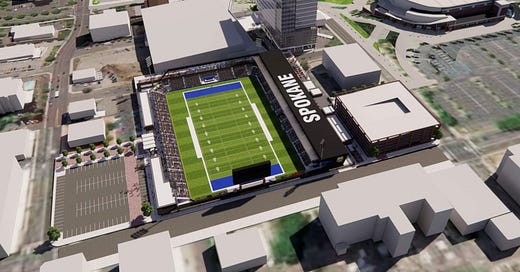Downtown stadium questions remain unanswered

A version of this piece originally appeared in the April 2021 edition of Spokane-Coeur d'Alene Living magazine. Subscribe at spokanecda.com.
The proposal for a downtown stadium has returned, and by all accounts the School Board is in a sprint as it makes a choice between the downtown option and continuing down its path of replacing Joe Albi Stadium at the Albi site.
It’s hard to believe that the downtown stadium proposal was first mooted almost three years ago. Back then, advocates proposed a five-thousand-seat stadium north of the under-construction sportsplex to house high school athletics, a minor-league soccer team, and other events. The proposal deserves more scrutiny now, in light of the coronavirus-induced downturn and a worsening local housing affordability crisis. It also deserves more scrutiny for the simple fact that it would be located downtown, on some of the most prime real estate in eastern Washington.
Unfortunately, most of the questions raised years ago remain unanswered today.
Transportation
Most critically advocates are still dodging important transportation questions.
Similar arenas, stadiums, and sports facilities across the country are embracing alternative transportation by providing bus passes with every event ticket, improving pedestrian and bicycle access, and funding circulator bus routes to encourage more people to park off-site. In Seattle, for example, the new Kraken NHL team even plans to subsidize monorail trips starting later this year.
In Spokane, by contrast, stadium boosters are proposing to tear down down another entire city block (currently home to Value Village) for additional surface parking and provide it free-of-charge for school events. Just imagine this mess of drivers trying to get in and out of these acres and acres of parking lots on event days. Now imagine there’s also an event at the arena, and another at the new sportsplex. It would be a disaster, and more importantly, a terrible experience for visitors.
Any downtown stadium must prioritize alternative transportation options to minimize the number of people arriving in a car. Maybe a GSL pass or event ticket could double as an STA pass on event days. The city could expand its walk- and bike-friendly options around the arena, by providing protected bike lanes and safe sidewalks. The arena district could offer free, premium parking to those who carpool with at least four people in a car. And perhaps a free circulator bus could offer connections to parking lots across the city, spreading out ingress-egress and reducing the inevitable mess on the North Bank.
If stadium boosters fail to adequately consider transportation, that alone would be enough, in my view, to scuttle the proposal.
Opportunity Cost
That said, we should also consider the opportunity cost of a new downtown stadium.
In other words, what else could be constructed there? A new stadium would be a fifty-year investment, and the North Bank has long been eyed for housing development and other amenities.
Providing more housing close to downtown brings people closer to jobs, amenities, and community events. It decreases traffic, reduces carbon emissions, and makes our city more walkable. From an economic development perspective, long-term residents can provide a sustained, long-term, and daily customer base for nearly all local businesses. Stadium visitors, meanwhile, would benefit mostly restaurants and hotels—and even then, only when an event is taking place. Whenever the stadium is empty, those businesses will do no better than they do today.
That means by building a stadium, and not some other use, we could actually be harming our local economy in the long-term. We need more study to know the highest and best use of the stadium property.
Democratic Process
Finally, there’s the simple issue of the advisory vote held in 2018, in which almost two-thirds of Spokane residents said they preferred constructing a new stadium at Joe Albi, as opposed to the location near the Spokane Arena. To change course now—after the public weighed in resoundingly and Spokane Public Schools has already invested hundreds of thousands of dollars into the Joe Albi site—could jeopardize the credibility of local elected officials and organizations with the general public.
To be fair, this isn’t the first time a public project has been resurrected after a failure at the ballot box. The Spokane Coliseum, the precursor to the arena, was famously voted down twice. So was a bond measure which would have funded Expo ’74. Seattle famously rejected a mass transit system––twice––in the 1970s. In each of these cases, local leaders had to get creative, tweak their plans, and practice transparent communications to get the public on board.
The Downtown Spokane Partnership and other stadium boosters should do likewise today. Otherwise, they risk destroying their credibility and that of the School District. And that's not something worth risking.
Conclusion
So, should we build a stadium downtown?
I honestly don't know. I haven't even gotten into the fact that USL League One is a fragile, two-year old, third-tier soccer league without a demonstrated record of financial success, and I've already raised three important problems with the stadium proposal as it stands.
I think I could get to "yes" if these very real issues were addressed. But in the absence of a deeper conversation, and in the absence of more research on the highest and best use of the property, I'd vote "no" if I were a school board member. The existing proposal just isn't fleshed out enough as it stands. If proponents want to spend the money to study the issue further, and delay construction at Joe Albi, then by all means, go ahead! But if it's now or never, then perhaps now's not the time.




